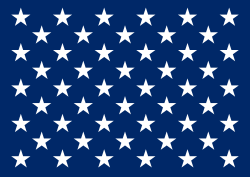 Jack of the United States as seen on the flag of the United States | |
| Union Jack | |
| Proportion | 71:100 |
|---|---|
| Adopted | 1777 (initial use of underlying design template) July 4, 1960 (current design) July 4, 2019 (readopted) |
| Design | 50 white five-pointed stars defacing a blue field in 9 rows, alternating between 6 and 5 stars (top to bottom), or 11 rows alternating between 5 and 4 stars (left to right). |
The jack of the United States, referred to as the Union Jack [1] by the U.S. Navy, is a maritime jack flag flown on the bow of U.S. vessels that are moored or anchored. In addition to commissioned U.S. Navy ships, the jack is used by the U.S. Coast Guard, [2] the Military Sealift Command, the ships of the National Oceanic and Atmospheric Administration, and other U.S. government entities. While anchored or moored, the jack is flown on the bow of a ship, and the ensign (which, for the U.S. Navy is the national flag) is flown on the stern. Once under way, the jack is lowered. [3]
Contents
The Union Jack was adopted on June 14, 1777, [1] alongside the U.S. national flag itself. [4] Since then, the jack has essentially consisted of the canton of the national flag, with each star added to the national flag being added to the Union Jack also. [1]
It is widely held that, before the Union Jack, the jack of the United States was the First Navy Jack. [5] The exact historical appearance of this flag is disputed, but it is displayed today by the Navy bearing a rattlesnake and motto. [5] During the last several decades, the Union Jack has sometimes been temporarily removed from use—such as from 1975 to 1976, when the First Navy Jack was flown for the U.S. Bicentennial; in 2000, when submarines and submarine tenders flew a special jack for the hundredth anniversary of the first commissioned U.S. Navy submarine; [6] and for all warships from 2002 to 2019, when the Navy flew the First Navy Jack for the Global War on Terrorism.
The oldest commissioned warship in active U.S. naval status (that is, having the longest total period in active status) that is not USS Constitution (technically the oldest commissioned ship in the U.S. Navy but is only used for ceremonial purposes) or USS Pueblo (captured by North Korea in 1968 and is still commissioned in the U.S. Navy; it is currently a museum ship) flies the First Navy Jack, and is the only active U.S. warship that flies a different jack than the Union Jack. Currently, this ship is USS Blue Ridge.


































